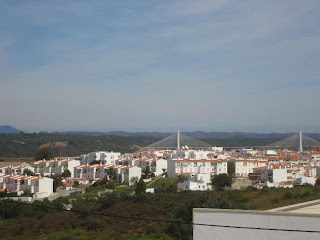Algarve's Tourist Guide - Architecture, Monuments and History of the Algarve
Lagoa, Algarve, Portugal Monumental Roadmap
Lagoa City and County
Lagoa is a Portuguese city of Algarve, Faro District, with about 6 100 inhabitants.
It is home to a small municipality with 88.50 km ² and 23 835 inhabitants (2006), divided into 6 parishes.
The municipality is bordered to the northeast by the municipality of Silves, Portimão is on the west, and by the Atlantic Ocean at south.
- History
Long before the reported achievements of the knight templar Dom Paio Peres Correia (1242-1246) the land of Lagoa have been conquered from the Arabs and consequently integrated into the kingdom of Portugal, being attached to the end of Silves.
On January 16, 1773 by a charter of the king El Rey Dom Jose was established the Lagoa County, having been elevated to town status after its principal settlement - Lagoa.
According to historical sources the original settlement of Lagoa born around a pond, where swamps have been dried in order to create fertile land and homes where people of the Muslim empire eventually settled.
The natural resources of the region contributed greatly to the current economic structure based on the following activities: agriculture, fishing, small industry and tourism.
The fishing activity (communities of Ferragudo, Benagil, Carvoeiro and Senhora da Rocha), the cultivation of vines and traditional culture were rainfed until a few decades ago, the main sources of revenue of the municipality.
Driven by fishing, canning, early last century, devastated these stops bringing great prosperity and wealth.
However, from the 60s, tourism was the main driver of the county, creating the structures necessary for the growth of the economy, with important consequences in the labor market, particularly in terms of creation of work.
This activity quickly established itself as a motor of the local economy, the great lever of development, becoming a permanent and structural nature of the county's economy.
Along with tourism, has grown a whole range of activities, especially in services, construction, commerce and industry.
- Lagoa Today
Lagoa is now as a tourist area of the Algarve.
There are several factors contributing to this recognition, particularly the variety of offerings (the beauty of its beaches - backed by magnificent hotels, golf courses, cultural heritage), the correct land use in terms of planning, the social stability and the friendliness of its people.
With a renewed cultural view, advocated by tourism, lagoon embracing several ancestral techniques, linked to pottery, to desserts, with the aim of maximizing the value and as a component of the tourism product.
As proof of this promotion is a great craft show, held annually at Exhibition Park Pond - FATACIL.
Some heritage buildings have been the target of initiatives to make them living spaces of culture, including the Municipal Library and the Convent of St. Joseph - Cultural Center of the City of Laguna - which carries out performances of various kinds and origin, exhibitions among other activities.
Furthermore, it should be noted also, the many cultural activities take place at Parque Municipal das Fontes, in Estômbar, throughout the year, including theater, dance and traditional singing.
Over the past 15 years, Lake has one of the highest rates of economic development in all municipalities in the Algarve region.
Today is endowed with numerous facilities in health, education and education, sport, leisure and tourism.
- Parishes
The 6 villages of Lagoa are:
Praia do Carvoeiro
Estômbar
Ferragudo
Lagoa
Parchal
Porches
All parishes have the status of towns, except Lagoon, which has the status of a city.
- Beaches
It has beaches in visible growth, both infrastructure, both water quality and surrounding environment, now beginning to compete with the attractive beaches of Portimão and Albufeira.
From the beaches of this county, there are the following:
Praia de Albandeira (Albandeira beach)
Praia da Angrinha (Angrinha beach)
Praia do Barranco
Praia do Barranquinho beach
Praia de Benagil beach
Caneiros Beach
Praia do Carvalho
Carvoeiro beach
Praia da Cova Redonda
Praia de Ferragudo
Praia Grande Ferragudo (Ferragudo big beach)
Levante Beach
Praia da Marinha beach
Praia do Mato
Praia do Molhe beach
Praia Nova
Praia da Senhora da Rocha
Paia do Pintadinho
Praia dos Lupines
Praia do Vale de Centeanes (Centeanes Valley Beach)
Heritage
Igreja Matriz de Lagoa (Lagoa Mother Church)
Igreja Matriz de Estômbar (Estômbar Mother Church)
St. Joseph Convent
Convento de Nossa Senhora do Carmo
Fort St. John Arade
Natural Curiosities
Algar Seco Grottos
Sítio das Fontes


































0 comentários:
Enviar um comentário